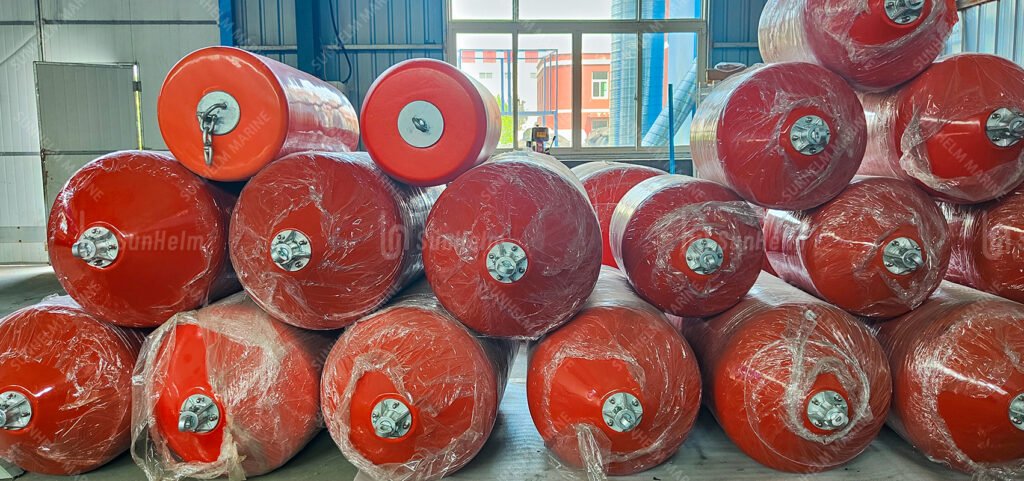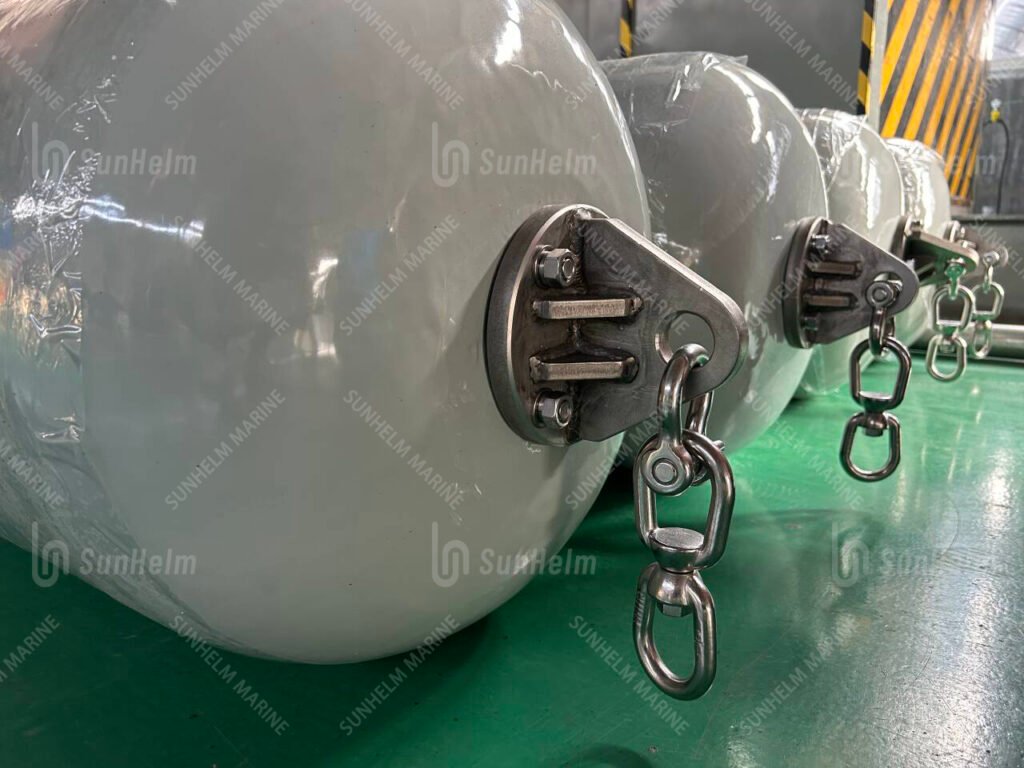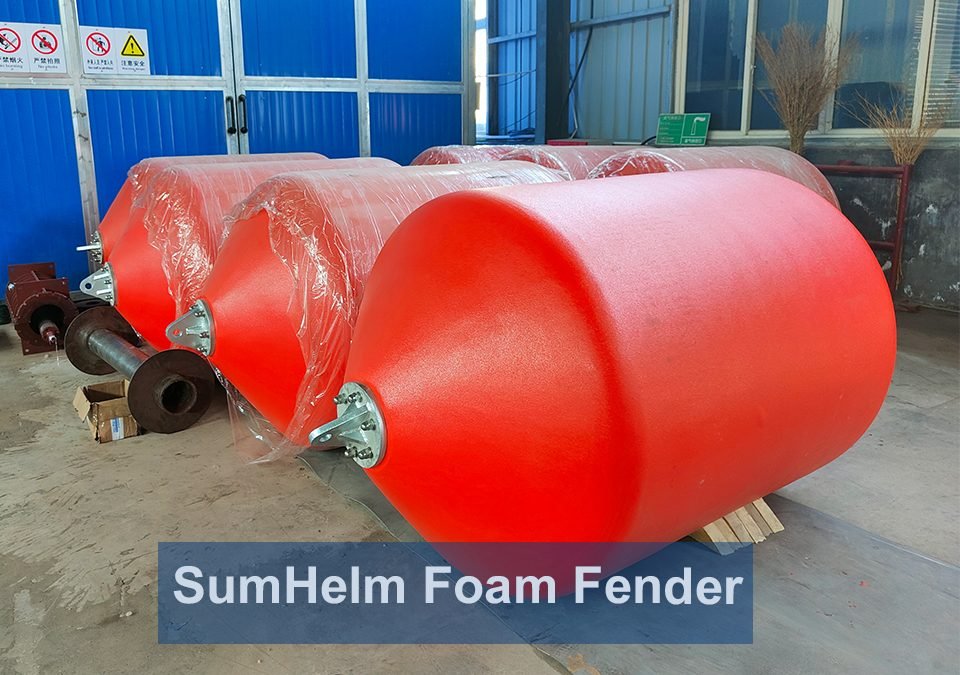Choosing the right foam fender is one of the most important steps in building a safe and efficient port. The right fender can protect both your ships and your quay structure, reduce long-term maintenance costs, and improve docking safety. But with so many sizes, materials, and performance options on the market, how do you make the right decision?
This guide walks you through the process, with simple explanations and practical tips for port designers and operators who already have some experience with foam fenders.

Key Performance Factors to Consider
Before looking at real-world conditions, it helps to understand what makes a good foam fender.
1. Energy absorption
This shows how much kinetic energy the fender can take in during a ship’s impact. The higher the energy absorption, the better the protection. Always check the manufacturer’s data sheet (measured in kJ at 60% deflection).
2. Reaction force
This is the force the fender pushes back onto the vessel and quay. You want this value to stay below your structure’s maximum design load.
3. Deflection and recovery
A good foam filled fender compresses under impact and quickly returns to its original shape. Quick recovery means it’s ready for the next docking operation.
4. Size and length
Diameter and length depend on vessel size and type. Large cargo ships or tankers require larger fenders for more energy absorption.
5. Outer skin material
Foam fenders usually have a durable polyurethane or rubber skin. Choose a skin that can handle your local climate, UV exposure, and chemical environment.
6. Lifespan and maintenance
Check the product’s expected life and maintenance needs. Quality foam fenders can last 10–15 years with minimal care.

Understand Your Working Conditions (Main Section)
Your port’s unique environment plays a major role in selecting the right foam fender. Before buying, take the time to evaluate the real-world conditions your fenders will face. This will help you find the balance between performance, cost, and durability.
1. Type of vessels
The size and type of ships using your berth are the first things to consider.
- Cargo ships or container vessels need fenders with high energy absorption.
- Tugboats and service vessels require smaller, lighter fenders that can handle frequent contact.
- Oil tankers or LNG carriers may need fenders with low reaction force and chemical-resistant skins.
2. Berthing method
Different berthing angles and speeds produce different energy levels.
- Parallel berthing spreads the impact along several fenders, reducing the load per unit.
- Angled or corner berthing causes more concentrated energy on a smaller area, so you need stronger fenders with better deflection control.
3. Tidal range and water level
If your port has a large tidal variation, you must install foam fenders that can stay effective across all water levels. In such cases, larger vertical coverage or multiple rows may be needed.
4. Water current and wave conditions
High current or wave energy adds extra pressure on fenders. Choose stronger mounting systems and check that your foam filled fenders can resist long-term hydrodynamic forces.
5. Environmental exposure
Your environment determines the type of fender coating you need:
- Strong sunlight or UV radiation → UV-resistant polyurethane skin.
- Cold climates → flexible materials that don’t crack in low temperatures.
- Chemical or oil exposure → skin resistant to fuel, solvents, or acids.
- Marine growth → easy-to-clean surfaces or protective paint coatings.
6. Structural limitations of the quay
Every quay has a maximum load it can handle. Make sure the reaction force from the fender system stays below that limit. If not, you risk damaging both the quay and the vessel.
7. Docking frequency
A berth used daily needs more durable fenders than one used occasionally. Continuous berthing also causes heat buildup inside the foam, so ensure your fenders are designed for high-cycle operations.
By studying these conditions carefully, you can choose a foam fender that performs well under real use—not just on paper.
Step-by-Step Selection Process
- Collect key data – Vessel dimensions, berthing velocity, tidal range, and allowed reaction force.
- Match energy absorption – Compare your energy values with the manufacturer’s performance charts.
- Check reaction limits – Ensure the fender’s reaction is below the quay’s structural limit.
- Select size and quantity – Determine the number of fenders and spacing to cover the impact zone.
- Consider installation – Check available space, hardware, and mounting methods.
- Review durability and serviceability – Choose fenders with proven long-term performance and easy maintenance.
Real Applications and Examples
- Container terminals use large-diameter foam fenders for heavy energy absorption and low rebound.
- Oil and gas terminals prefer foam fenders with chemical-resistant polyurethane skins.
- Tugboat berths rely on small, solid foam filled fenders with high impact tolerance and minimal maintenance.
Each situation has different priorities—no single fender fits every berth.
Procurement and Inspection Tips
When requesting quotations, make sure your specification includes:
- Energy absorption and reaction force data
- Fender size and shape
- Material and coating details
- Certificates or test reports
- Warranty terms and expected lifespan
During inspection, check:
- Skin thickness and smoothness
- Label and batch numbers
- Dimensions and mounting points
- Overall surface quality (no cracks or delamination)
A quick check before installation can save you years of maintenance trouble.
Maintenance for Longer Service Life
- Wash off salt and dirt regularly.
- Check the skin for cuts, cracks, or separation.
- Inspect mooring chains and brackets for rust or deformation.
- Record inspections in a simple maintenance log.
Well-maintained foam fenders can perform reliably for more than a decade.
Quick Checklist Before Purchase
- Does it handle your vessel’s energy range?
- Is the reaction force safe for your quay?
- Does the skin resist UV, oil, or temperature changes?
- Is it easy to install and maintain?
- Do you know the total cost over its lifetime?
If you can answer “yes” to all these, you’re close to the right choice.
FAQ
Q1: Are foam fenders better than pneumatic ones?
A: They’re different. Foam fenders need no air pressure, require less maintenance, and work well for frequent berthing. Pneumatic fenders are lighter and give lower reaction force.
Q2: How long can a foam fender last?
A: Usually 10–15 years, depending on UV, temperature, and docking frequency.
Q3: Can I use foam fenders in offshore conditions?
A: Yes, if you choose models with strong skins and reinforced mounting systems.
Q4: How do I know what size I need?
A: Use the manufacturer’s energy chart. Match your berthing energy (in kJ) and check that reaction stays within limits.
Final Thoughts
Choosing the right foam fender isn’t just about picking a size from a chart. It’s about understanding your working environment, your ships, and your quay’s limits. By focusing on real operating conditions, you’ll find the balance between safety, performance, and long-term cost.
At Sunhelmmarine, we help port designers and operators choose reliable foam filled fenders built for their exact needs. If you’d like a tailored selection guide or specification sheet, feel free to reach out — we’re here to make your fender decision simple and smart.


